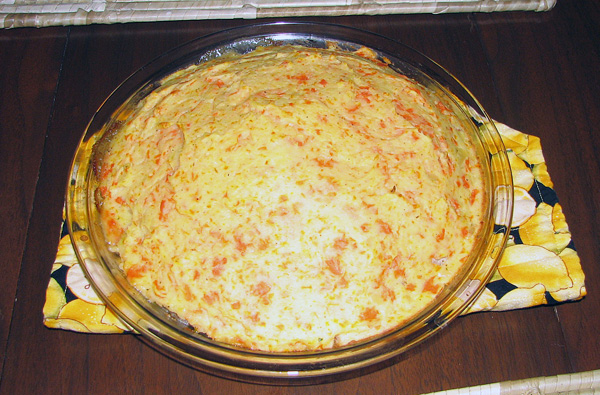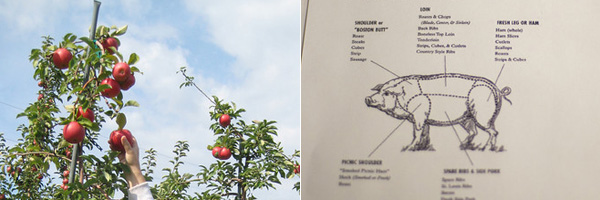
As we bring Heavy Table Pie Week to a close, we present a few gastronomic pie-related oddities for your enjoyment.
Squirrel Pot Pie
By Susan Pagani
Not long ago, a great hunter we know took a young boy and his father out for a day of pheasant hunting. The boy, just learning to use his gun, did not have as successful day as he might of liked, and so our friend offered to help him shoot a squirrel. Sure enough, the boy spotted one, darting out of the corn and running along the road. They shot and cleaned the squirrel, but even in consideration of all that good corn it likely had been eating, the boy declined to eat the squirrel, and the father — wary of how the mother might feel about preparing the critter — didn’t push it.
And that’s how I came to have a squirrel in my icebox. I can’t fault the boy for not wanting to eat it. Laying in a Ziploc sandwich bag, frozen, with no head or tail, squirrel nutkin looked like a little man with no shirt on (well, no skin really), his tiny bone arms and legs sticking out to either side.
 I baked him into what we call Squirrel Pot Pie, mainly because it’s fun to say, but it actually more closely resembles a shepherd pie. As it cooks, squirrel gives off a very pungent, very musky smell, which I found rather unappetizing. In the actual pie, it was quite tasty; similar to, say, the dark meat of a chicken, or to pheasant, but less tender, more chewy.
I baked him into what we call Squirrel Pot Pie, mainly because it’s fun to say, but it actually more closely resembles a shepherd pie. As it cooks, squirrel gives off a very pungent, very musky smell, which I found rather unappetizing. In the actual pie, it was quite tasty; similar to, say, the dark meat of a chicken, or to pheasant, but less tender, more chewy.
After this initial foray, I learned that the chewiness — and even the strong cooking smell — can be mitigated by boiling the meat with a potato and an onion (until it falls off the bone) prior to using it, or simply soaking it in salt water, changing the water often, for 24 hours.
Notes: If you don’t have enough or any squirrel, you can substitute pheasant or chicken. This recipe assumes the squirrels are already processed, i.e. no fur or innards. Also, it should go without saying, but just in case: Unless you live on a farm, don’t eat the squirrels in your back yard.
Squirrel Pot Pie
(Serves 6 to 8)
Filling
3 lb of squirrel meat (3 to 4 squirrels)
2 onions, quartered
2 potatoes, halved
A few sprigs of fresh thyme
2 tbsp butter
2 large leeks thinly sliced
2 c button mushrooms, sliced (if you dislike mushrooms, substitute in ½ c sliced carrots, ½ c sliced celery and 1 c savoy cabbage)
4 to 6 oz chevre
2 tbsp parsley, chopped
Salt and pepper
Crust
1 lb potatoes, peeled and quartered
8 oz carrots, roughly cut
2 tbsp butter
1 egg, beaten
pinch of nutmeg
Salt and pepper
Preheat the oven to 375 degrees.
1. Put the squirrels, into a large pot with the onions, potatoes and thyme. Cover them with water, bring to a boil and simmer for about an hour or until the meat falls from the bone.
2. Meanwhile, to make the topping, cook the potatoes and carrots in a large pot of lightly salted boiling water until tender. Drain well and then mash together. Beat in the butter and egg, and then season to taste with nutmeg, salt and pepper.
3. Strain the liquid off, keeping only the squirrel meat. Do not be tempted to keep the stock for soup making or gravy. Throw it away. Once the squirrel has cooled, chop it into bite size chunks and set it aside in a 9-inch pie plate.
4. Melt the butter in a medium skillet and sauté the leeks and mushrooms (or other vegetables) over a moderate heat until they are tender. Stir in the chevre and parsley, and spread the mixture over the squirrel.
5. Evenly distribute the mashed potatoes and carrot over the squirrel and veggies, swirling it into a peak.
6. Bake for 20 to 25 minutes, or until the topping is lightly browned, and serve hot.
The Pie Shake at Hamburg Inn No. 2, Iowa City, IA.
By John Garland
The Hamburg Inn (214 N. Linn St.) is the one Iowa City restaurant that could rightly be termed an institution. It has developed a reputation as the perfect folksy meet-and-greet spot for national candidates during the Iowa caucuses. Reagan and Clinton have both made appearances there; an episode of The West Wing featured it prominently. It’s a classic greasy spoon – breakfast all day, no frills. It’s both loved and reviled. Some consider it the holy grail of hangover killers, others get ticked off by the slow service and find the food bland and overpriced. Like the restaurant itself, its signature item seems very familiar but has that certain je ne sais quoi that makes it truly memorable: The Pie Shake ($5.49).
It is exactly what it sounds like – a piece of pie blended with vanilla soft-serve into a milkshake; a la mode taken to the illogical extreme. It doesn’t seem particularly notable, especially now in the age of countless “food-stuck-inside-different-food” memes floating around on the Internet. But even with newer breakfast places opening in Iowa City recently, awnings that proclaim “Famous For Our Pie Shakes” will continue to draw hoards of curious new freshmen to the ‘Burg.
It tastes almost exactly like you would expect it to, I mean, it’s pie and ice cream. Amazingly, though, it doesn’t come off as overly sweet. The soft serve has enough flavor to stand up to whatever pie is blended into it. In fact, if not for the flecks of crust, a blind taste tester might not even put the pie connection together. The blended crust almost mimics a kind of malted-milk flavor to the point where you can appreciate it as a milkshake, and not a thinner, less chunky Blizzard. If they have it when you’re there, try it with a tart fruit pie – rhubarb and peach are both winners.
The Pie Shake seems equal parts campy, old-fashioned and earnest – like if Norman Rockwell had painted Turduckens. It has no place as a beverage with a meal, especially not the stick-to-your-ribs type you’ll get at Hamburg. It’s best enjoyed in the middle of the afternoon, between the lunch and dinner rushes. You can sit in peace, sip your pie, and ogle the walls full of plaques, pictures, letters and awards from celebrities, journalists and politicos – all happily espousing the wonder of the deeply satisfying shake.

Lunch-and-Dessert Pasties
By James Norton and Becca Dilley
While researching Minnesota Lunch: From Pasties to Banh Mi, we came across stories documenting a curious phenomenon: pasties that were a clever combination of lunch and dessert. In the book, we wrote:
“A housewife would make pasties for underground miners,” recalls cookbook author Eleanor Ostman. “There’d be a meat mixture for two-thirds of the pasty, and the last third would be filled with [fruit] preserves.” Pressing down the dough between the two pockets of food helped keep them separate. Food writer Sue Doeden recalls pasties that were “Half full of a sweet filling, like jam, or apple pie filling. So they’d eat the first half, and they’d put the pasty back in their pocket and pull it out later when they were hungry for dessert.”
We built our own version of semi-mythical sweet/savory pie beast using apples and sweet potatoes to bridge the gap between a pork-based meal and an apple-based dessert. Although we initially considered a crimp to separate the two halves, eventually we figured that the two have enough in common gastronomically that a little mingling won’t hurt anything.
Lunch-and-Dessert Pasties
From Minnesota Lunch: From Pasties to Banh Mi
Makes 4 servings
Crust
5 c all-purpose flour
1 tbsp salt
2 c (4 sticks) cold, unsalted butter, cut into 1/2 inch cubes
1 large egg
1 tbsp apple cider vinegar
About 1 c ice water
1. Combine flour and salt in a large bowl. With a pastry cutter or your fingertips, blend in butter until mixture resembles coarse meal with roughly pea-sized butter lumps. Using a fork, beat egg and vinegar in a 1-cup measure. Add water to measure 1 cup total. Add liquid mixture to flour mixture, stirring until incorporated.
2. Turn mixture onto a lightly floured surface and knead gently to bring dough together. Roll out into a 15×9-inch rectangle. Arrange dough with short side nearest you and fold into thirds, creating a 5×9-inch rectangle. Wrap dough in plastic and chill for at least 1 hour.
Pork Filling
3/4 lb trimmed pork chop, cut into half-inch cubes
1 tsp coarse salt
½ tsp freshly ground black pepper
Pinch cayenne pepper (optional)
2 tsp vegetable oil
1 c chopped white onion (about X medium/large)
1 c quarter- to half-inch cubed Granny Smith apple (about X medium)
1 c quarter-inch cubed sweet potato (about X medium/large)
Combine pork with salt, black pepper, and cayenne (if using). Heat oil in a skillet over medium-high heat. Add pork, cooking for 1 to 2 minutes and stirring constantly, until most of the meat’s exterior has changed color. Remove meat to bowl. Reduce heat to medium low, add a bit more oil if necessary, and cook onions, stirring, until tender, 4 to 5 minutes. Remove from heat; add to pork. Combine apples and sweet potatoes with pork and onions. Set aside.
Apple Pie Filling
3 small-to-medium Granny Smith apples, cored and sliced
3 tablespoons sugar
1½ tbsp brown sugar
1 tbsp flour
¼ tbsp lemon zest
½ tbsp lemon juice
Pinch salt
Pinch cinnamon
Combine all ingredients (apples through cinnamon) in a bowl and mix well. Set aside.
Assembly
Butter
Water or milk
1. Preheat oven to 400ºF. Using one-quarter portion of chilled dough, roll out a 10-inch round. Place about 1 cup apple mixture near left-center of dough round. Place about 1 1/2 cups pork mixture near right-center of dough round. Divide a thin pat of butter, putting half atop each mixture.
2. Lightly brush edges of dough with water or milk. Fold over dough into a half-moon shape, and crimp sides using a fork or your fingers to seal. Use a knife to cut slits in the top: 2 slashes for meat, 1 slash for apples. Repeat process to make 3 more pasties.
3. Bake about 35 minutes. The apples should be bubbly and releasing liquid and the pork cooked through. Serve.

Comments are closed.